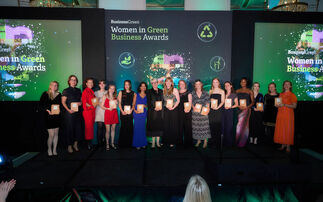Nesta Challenge's Constance Agyeman makes the case for human centred design to deliver the Sustainable Development Goals
Last week, world leaders convened for the 74th UN General Assembly to review the progress in implementing the UN Sustainable Development Goals. The goals include important and tough challenges: ending poverty, ending hunger, quality education for children, sustainable economic growth, climate action and more. There are 17 goals in total, all to be achieved in little over a decade and requiring a global effort of cooperation and action to deliver.
The Sustainable Development Goals are the successors of the Millennium Development Goals. Instituted in 2000, they made extraordinary advances in improving the quality of life for hundreds of millions in developing countries.
Rates of extreme poverty fell from 47 per cent in 1990 to 14 per cent in 2015. Primary school enrolment in sub-Saharan Africa climbed from 52 per cent in 1990 to 60 per cent in 2000 all the way to 80 per cent in 2015. The global number of deaths of children under five fell from 12.7 million in 1990 to six million in 2015, whilst measles vaccination helped prevent nearly 15.6 million deaths between 2000 and 2013.
Cutting extreme poverty to 14 per cent was a massive achievement, but with the global population expected to reach 8.5 billion in 2030, it leaves the prospect of 1.19 billion people living on less than $1.25 a day. It's vital that the successor challenges in the Sustainable Development Goals are met. They will require innovative solutions, often technological - they will only succeed by putting the people impacted the most at the heart of solutions.
Challenges are good; they focus our attention, concentrate our resources and give innovators a target to aim for. I say this as someone who works with challenges on a daily basis with my work to promote sustainable communities through international development. We identify the most pressing issues we face and develop Challenge Prizes to incentivise innovators and entrepreneurs to develop lasting solutions to those problems, awarding them with significant cash prizes if they win. We've awarded more than £19m through our challenges in equity-free prizes and seed funding.
The Data Driven Farming Prize was a partnership with USAID to challenge innovators to harness technology to create apps, sensors, software and widgets capable of improving smallholder productivity in Nepal.
We awarded $300,000 to four winners in 2017, including the Plantix app which diagnoses crop diseases from pictures taken by farmers and KrishiGuru, a Nepali winner, which is helping farmers secure the right prices for their goods whilst providing accurate weather data and pest prevention advice.
The Fall Armyworm Tech Prize tackled devastating outbreaks of the invasive pest in Africa which could potentially cause $13bn in losses of crops. The prize sought digital tools that enabled smallholder farmers to identify, treat, and track incidence of fall armyworm to reduce productivity losses. We awarded four prizes totalling $450,000 to the most viable and promising solutions.
Farm.Ink's Fall Armyworm Virtual Advisor won the grand prize, providing the knowledge to identify, scout, and treat fall armyworm to its users. The tool is integrated into the Nairobi-based mobile service, Africa Farmers Club, an online group and chatbot that enables more than 150,000 farmers across Africa to find information about farming.
For these prizes to meet their aims, the principles of human-centred design were woven throughout each one. This helped to ensure the winning innovations met the needs and lives of the people they needed to benefit most.
The conventional approach to innovation is to build a new technology that one thinks will solve a problem and assumes is what people want - it's then put into market to see what happens, maybe it swims, maybe it sinks.
A classic example is the Google Glass - connected spectacles that could display the internet to the wearer and record what they could see. Every aspect of the design was carefully thought through, except perhaps for the most important component for its functionality - people. The backlash in 2013 against the wearable's covert surveillance capabilities of the Glass was almost immediate, with poor take-up, the technology juggernaut ended production.
Human-centred design finds out what people really need and how they might engage with potential solutions. There's little point developing the best web-connected app in the world to solve a pressing problem for Nepali farmers, if they have neither the right smartphone nor 4G mobile coverage to use it. Challenge prizes show us that without speaking to the people most impacted, we cannot hope to determine what the appropriate solutions will be. This is the lesson I sincerely hope will be applied to the UN Sustainable Development Goals.
Human centred design is a state of mind to always have people at the core of planning, thinking and doing. It is the process of applying that thinking into the design and delivery of programmes, products and services. Human centred design means we never forget what we are doing is to benefit, engage and involve people, so that we gain a clearer understanding of the way they will interact with and influence whatever it is we are designing. Ultimately it will generate something much more credible and, in turn, more likely to succeed.
That's the point, the challenges laid out in the Sustainable Development Goals must succeed. Ending poverty and ending hunger are lofty ambitions. We didn't achieve them with the Millennium Development Goals and we may not achieve them this time around. However, the advancements made between 2000 and 2015 show that significant progress is possible and that they are not out of reach.
In order to achieve the 2030 goals, human centred design needs to be a central pillar. Each goal is rooted in improving the quality of life for people; the impacts of programmes and solutions, positive and negative, short-term and long-term, need to be considered. For the goals to be truly sustainable, they need to have buy in, involvement and credibility within the communities they serve, particularly if short-term funding is involved. Our most successful challenge prizes have shown us that often these solutions come from local innovators - their proximity to an issue makes a large difference (rather than parachuting solutions into a context that is not well understood).
For government, for industry, for aid organisations and charities, human centred design will mean fewer misses and greater impacts; the growth of local ecosystems, addressing issues that governments are grappling with and lessening the reliance on NGOs as gatekeepers of the solutions to the problems societies face. The Sustainable Development Goals can and should be achieved, but the solutions will only work if people are placed at the very heart of our approach to realising them.
Constance Agyeman is head of international development and communities at Nesta Challenges






